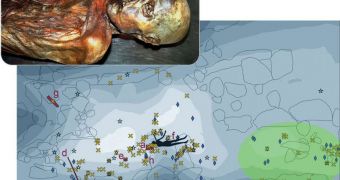Researches believe they may have stumbled upon some of the oldest signs of burying rituals ever discovered, which appear to have been left behind some 5,000 years ago.
The artifact the experts studied was the Otzi skeleton, which was discovered in the Alps some 19 years ago. The Iceman was until now thought to have been killed by a blizzard.
However, in the latest studies conducted on his remains, it was discovered that the markings on Otzi's body did not support a hypothesis in which he was entombed by massive precipitations.
The new data appear to indicate that the man was buried at the location during the summer months, by a group of related humans, and in a ceremonial ritual. The idea is supported by studies of Otzi's possessions, which were discovered near him.
The investigators who conducted the research, led by University of Rome, La Sapienza archaeologist Alessandro Vanzetti, focused their attention on making sense of the entire death scene.
The body was discovered back in 1991 by two hikers strolling across the Austrian-Italian border, who also found various objects scattered around Otzi's remains.
These artifacts include a backpack, a copper ax, a container, a dagger and a bow. At first, researchers believed that the man had discarded and scattered these objects as he was dying.
Experts found the marks of an arrowhead in his shoulder, and they believed that the man was attacked by an enemy, who left him to face the blizzard until death came.
But the new analysis of the entire death scene did not agree with these findings. The objects were in fact placed carefully near the body, on a stone platform built especially for this goal.
It is believed that the rocky structures, located some 5 meters from the body, contained all the objects, but that wild animal and the elements scattered them around, except for the backpack.
The investigators sued a research technique called Spatial Point Pattern Analysis (SPPA) to make sense of the death scene, and account for the distribution of the objects around Otzi's remains.
The team believes that the man's shoulder wound would have prevented him from venturing in the mountains in any case, and says that, most likely, Otzi died in April, and was buried in September.
This conclusion is based on dating measurements conducted on the food in his stomach, and on the pollen trapped in ice at the location.
But not all researchers are convinced that Otzi was buried. Some still argue that he was killed, arguing that the body was found upright, a very unusual position for burial, ScienceNow reports.

 14 DAY TRIAL //
14 DAY TRIAL //